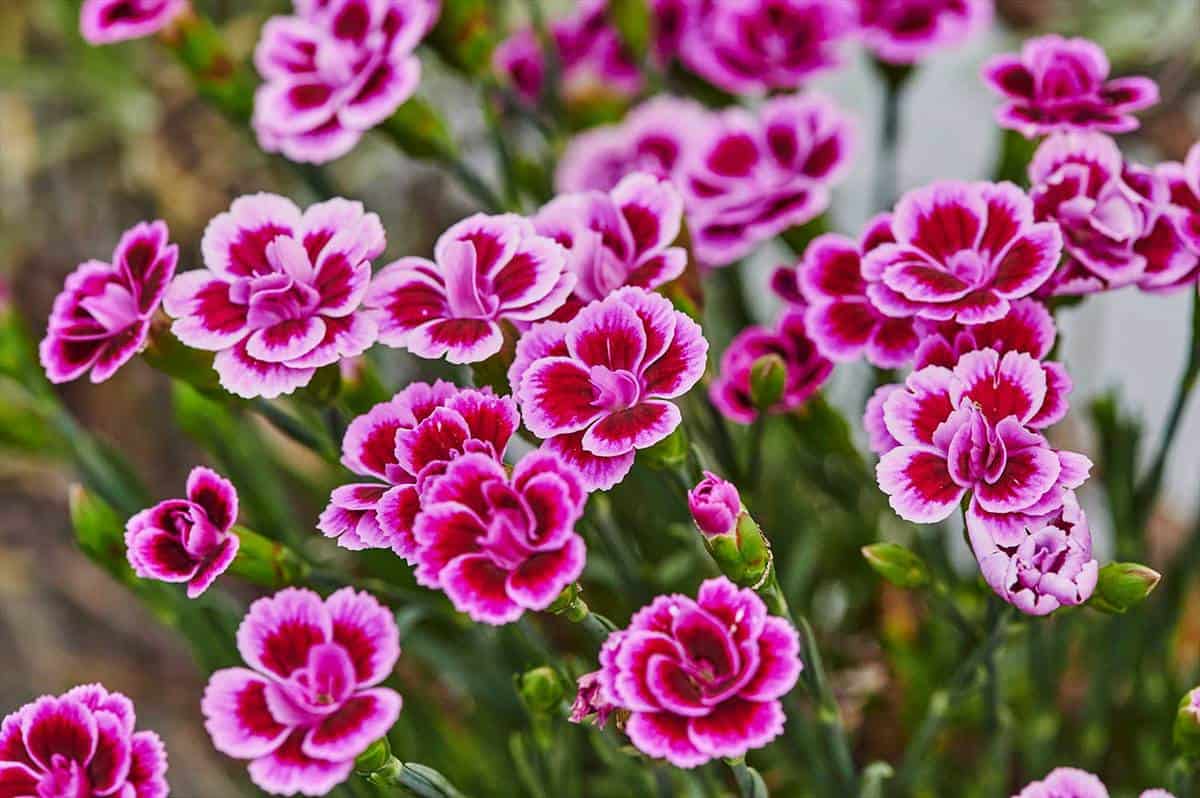Dianthus plants are some of the most beautiful cottage flower shrubs that you can find. Their blue-green foliage is eye-catching and fragrant. But how do you know when to transplant them? And when do you do it? We've looked into the best method to do this, and we'll answer these questions for you.
It's best to plant the dianthus in early spring before they begin to flower. If you live in a warm area, you can also transplant them at the last leg of fall, as long as it's at least 50 degrees Fahrenheit or warmer outside. This way, you won't risk breaking the roots if the ground is still frozen.
Here are the steps to transplant the dianthus:
- Dig a trench
- Remove the plant
- Remove the dirtball
- Separate the roots
- Pot the plants
- Find a sunny location
- Water the transplants
The great thing about the dianthus plant is that it is quite variable and has different colors and patterns to go with any type of yard or landscape. Keep reading to learn the best method to use for transplanting it effectively and safely.
![A colorful Dianthus flower blooming in garden, When To Transplant Dianthus [And How To]](https://gardentabs.com/wp-content/uploads/2022/01/When-To-Transplant-Dianthus-And-How-To-e1642660011116-683x1024.png)
Steps To Transplant Dianthus
Before transplanting your dianthus plant, it's helpful to first make a list of the tools you'll need for the job. Always make sure to use fresh and clean cutting tools to avoid spreading plant diseases and pests.

Things you'll need:
- New soil or compost
- New plant pots
- Gardening shears
- Garden shovel
- Rubbing alcohol
1. Dig a trench
Start by digging a trench around the dianthus plant's outermost leaves. You can also use a trowel for this task.
Be sure to place the tool deep enough in the ground to loosen up any soil around the plant while being careful not to accidentally cut the roots. Try to stay at least 2-3 inches around the perimeter of the plant.
Find this garden shovel on Amazon.
2. Remove the plant
Once the shovel reaches the bottom of the roots, slowly lift the plant up and out from the ground. Be sure to use caution during this step, as you don't want to accidentally snap the roots.
3. Remove the dirtball
Once the plant is off the ground, hold it by the base of the trunk and then shake it gently to remove most of the dirt from the root ball. The roots shouldn't be completely visible, but most of the dirt should be brushed away—you'll need to create room for the new soil.
4. Separate the roots
Next, gently pull the plants apart by the base (at the top of the root) into segments of three or four. You can also use a gardening knife or utility knife if the roots are more than 1-2 inches thick.
Find this gardening knife on Amazon.
5. Pot the plants
Next, place each plant in a separate pot. Be sure to have the pot partially filled with new, fresh soil. When placing the new plant in the pot, be sure to cover the roots and base of the plant with the new soil.
You have a few options when it comes to replanting soil. You can use a bit of organic compost or regular compost. However, instead of using mulch, consider using small pebbles or gravel to keep weeds at bay.
Mulch can cause fungus and rotting problems with these baby plants. If the plant runs into any health issues, be sure to use an all-purpose fertilizer to help restore any lost nutrients.
Check out these potting pebbles on Amazon.
6. Find a sunny location
Next, find a sunny area in your home to plant the newly divided dianthus plants. If you're going to plant them back in the ground instead of outside, make sure to dig holes that are a few inches wider and longer than the roots.
This way, they'll have room to establish themselves again. Also, be sure to place the plants at least one foot apart so that the roots and branches don't become entangled as they grow. Make sure that the soil in the ground is loose and well-draining.
Find these small plant pots on Amazon.
7. Water the transplants
Finally, water your newly transplanted plants for the first time. Be sure that the soil is kept moist until they start showing new growth.
It's a good idea to check on them every day or two just to ensure that they're receiving enough sun and fresh water. Keep in mind that plants in this state can be very sensitive for the first few weeks.
Does dianthus need to be cut back in the fall?
Yes, it's a good idea to trim these plants back in the fall. This not only helps to maintain the health and shape of the plant but encourages blooms as well. The stems and foliage can surprisingly tolerate several trims throughout the year. And as a result, the blooms will be lusher and fuller.
Also, these fast-growing plants can quickly become a burden if you have them planted in areas near walkways, driveways, and entrances. It's best to keep them on a trimming schedule to prevent them from being stepped on or causing a tripping hazard around your home.
Does dianthus need to be divided?

Dianthus plants don't necessarily need to be divided. However, dividing them is a great strategy if you want to plant them in areas that will take up a lot of space (such as driveways and sidewalk linings). These shrubs are typically used as border plants around homes, and dividing them can be done in a couple of ways.
You can easily divide them by cuttings or seeds. Spreading multiple plants around areas such as ground covers and retaining walls will make it much easier once you have divided the plant.
How many years does dianthus last?

The lifespan of these plants depends on their variety and the climate in which they're located. Some plant varieties are cold-hardy and disease-resistant enough to bloom every single year while other species may live for just a couple of years or one growing season.
Some species are biennials and others are perennials. These plants survive better in warmer environments, and they're more likely to bloom again each year when temperatures are above 60 degrees Fahrenheit. They'll also grow better in places where the soil is moist and well-draining.
However, if you do live in a warm environment, you'll want to keep an eye on potential pest infestations, as they can also prevent the plant from blooming again in the following spring.
For example, aphids are common pests that often plague dianthus plants. These insects suck the juices from newly grown leaves and buds, leaving them dry and brittle.
The best way to prevent them from overpopulating is to keep a watchful eye on your dianthus plants. Be sure to monitor them regularly. Spray them with water to remove pests, or use natural and commercial pesticides.
Find this pesticide on Amazon.
How do you multiply dianthus?
Dianthus plants are fairly easy to divide. It's best to divide them in early or mid-spring, as your chances of success are much higher during this time. Before you divide the plants, be sure to prepare their new location and make sure that the compost or soil is moist and well-draining.
Next, cut the plants using a gardening tool and place them in new pots or growing areas in your garden. Be sure that the newly transplanted plants receive at least 6 hours of full sun, and water them immediately after transplanting them.
Next, be sure to monitor them over the next several weeks to keep an eye on their growth and condition.
Should you deadhead dianthus?
Yes, it's best to deadhead dianthus plants. Deadheading dianthus plants encourages them to grow more fully and vigorously throughout the entire growing season.
Though these plants are relatively easy to care for, deadheading them is a great way to ensure that they produce the greatest number of blooms possible. Not only does it allow them to utilize more energy to grow fresh buds and flowers but it also helps to turn old flowers into seeds.
Wrapping Things Up
Knowing how and when to transplant your dianthus plant can make a world of difference when it comes to maintaining the plant and encouraging future blooms. It's also best to deadhead these plants throughout the year to encourage fuller and longer foliage growth.
You'll find that maintaining this plant properly will result in beautiful, fragrant flowers that will continue to grow back each year, given the right environment.
Before you go, be sure to check out these other posts:





